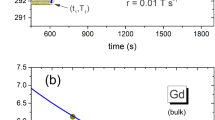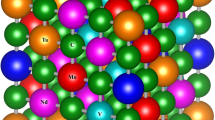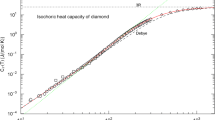Abstract
Contraction of solid elements and compounds by cooling from room temperature to 0 K or by mechanical pressing to the same volume at 298 K is experimentally determined. We found that the energy cost of cold compression exceeds the energy of mechanical compression on average by two orders of magnitude. This fact is caused by the different mechanisms of contraction: pressing directly reduces interatomic distances, cooling mainly reduces the amplitudes of harmonic vibrations of atoms, whereas the anharmonic part of the vibration energy, responsible for the thermal contraction, is very small, ca. 1%.


Similar content being viewed by others
Data availability
No datasets were generated or analysed during the current study.
References
Lennard-Jones JE (1931) Cohesion. Proc Phys Soc 43:461–482
Heinz H, Vaia RA, Farmer BL, Naik RR (2008) Accurate simulation of surfaces and interfaces of face-centered cubic metals using 12–6 and 9–6 Lennard-Jones potentials. J Phys Chem C 112:17281–17290
Morse PM (1929) Diatomic molecules according to the wave mechanics. Vibrational levels. Phys Rev 34:57–65
Girifalco LA, Weizer VG (1959) Application of the Morse potential function to cubic metals. Phys Rev 114:687–690
Rassoulinejad-Mousavi SM, Zhang Y (2018) Interatomic potentials transferability for molecular simulations: a comparative study for platinum, gold and silver. Sci Rep 8:2424
Birch F (1978) Finite strain isotherm and velocities for single crystal and polycrystalline NaCl at high-pressures and 300 K. J Geophys Res B83:1257–1268
Vinet P, Rose JH, Ferrante J, Smith JR (1989) Universal features of the equation of state of solids. J Phys Condens Matter 1:1941–1964
Schlosser H, Ferrante J (1993) High-pressure equation of state for partially ionic solids. Phys Rev B 48:6646–6649
Holzapfel WB (1998) Equations of state for solids under strong compression. High Pressure Res 16:81–126
Ponkratz U, Holzapfel WB (2004) Equations of state for wide ranges in pressure and temperature. J Phys Condens Matter 16:S963–S972
Villars P, Daams JLC (1993) Atomic-environment classification of the chemical elements. J Alloys Compd 197:177–196
Batsanov SS, Batsanov AS (2012) Introduction to structural chemistry. Springer, Dordrecht, New York
Young DA, Cynn H, Söderlind P, Landa A (2016) Zero-Kelvin compression isotherms of the elements 1 ≤ Z ≤ 92 to 100 GPa. J Phys Chem Ref Data 45:043101
Thermal Constants of Substances Database, Version 2 (2012) Joint Institute of High Temperatures RAS & Chemistry Department, Moscow State University, Moscow, Russia. https://www.chem.msu.ru/cgi-bin/tkv.pl
Dewaele A (2019) Equations of state of simple solids (including Pb, NaCl and LiF) compressed in helium or neon in the Mbar range. Minerals 9:684
Akahama Y, Kamiue K, Okawa N, Kawaguchi S, Hirao N, Ohishi Y (2021) Volume compression of period 4 elements: Zn, Ge, As, and Se above 200 GPa: ordering of atomic volume by atomic number. J Appl Phys 129:025901
Anderson MS, Swenson CA, Peterson DT (1990) Experimental equations of state for calcium, strontium, and barium metals to 20 kbar from 4 to 295 K. Phys Rev B 41:3329–3338
Takemura K (1997) Structural study of Zn and Cd to ultrahigh pressure. Phys Rev B 56:5170–5179
Anderson MS, Swenson CA (1985) Experimental equations of state for cesium and lithium metals to 20 kbar and the high-pressure behavior of the alkali metals. Phys Rev B 31:668–680
Dewaele A, Loubeyre P, Occelli F, Mezouar M, Dorogokupets PI, Torrent M (2006) Quasihydrostatic equation of state of iron above 2 Mbar. Phys Rev Lett 97:215504
Pandey KK, Gyanchandani J, Somayazulu M, Dey GK, Sharma SM, Sikka SK (2014) Reinvestigation of high-pressure polymorphism in hafnium metal. J Appl Phys 115:233513
Takemura K, Fujihisa H (1993) High-pressure structural phase transition in indium. Phys Rev B 47:8465–8470
Cynn H, Klepeis JE, Yoo C-S, Young DA (2002) Osmium has the lowest experimentally determined compressibility. Phys Rev Lett 88:135701
Winzenick M, Vijayakumar U, Holzapfel WB (1994) High-pressure X-ray diffraction on potassium and rubidium up to 50 GPa. Phys Rev B 50:12381–12385
Chen W, Semenok DV, Troyan IA, Ivanova AG, Huang X, Oganov AR, Cui T (2020) Super-conductivity and equation of state of lanthanum at megabar pressures. Phys Rev B 102:134510
Hanfland M, Loa I, Syassen K, Schwarz U, Takemura K (1999) Equation of state of lithium to 21 GPa. Solid State Comm 112:123–127
Sinton GW, MacLeod SG, Cynn H, Errandonea D, Evans WJ, Proctor JE, Meng Y, McMahon MI (2014) Equation of state and high-pressure/high-temperature phase diagram of magnesium. Phys Rev B 90:134105
Fujihisa H, Takemura K (1995) Stability and the equation of state of α-manganese under ultrahigh pressure. Phys Rev B 52:13257–13260
Hanfland M, Loa I, Syassen K (2002) Sodium under pressure: bcc to fcc structural transition and pressure-volume relation to 100 GPa. Phys Rev B 65:184109
Takemura K, Singh AK (2006) High-pressure equation of state for Nb with a helium-pressure medium: powder X-ray diffraction experiments. Phys Rev B 73:224119
Vohra YK, Ruoff AL (1990) Static compression of metals Mo, Pb, and Pt to 272 GPa: comparison with shock data. Phys Rev B 42:8651–8654
Frost M, Smith D, McBride EE, Smith JS, Glenzer SH (2023) The equations of state of statically compressed palladium and rhodium. J Appl Phys 134:035901
Zhao YC, Porsch F, Holzapfel WB (1996) Evidence for the occurrence of a prototype structure in Sc under pressure. Phys Rev B 54:9715–9720
Anzellini S, Wharmby MT, Miozzi F, Kleppe A, Daisenberger D, Wilhelm H (2019) Quasi-hydrostatic equation of state of silicon up to 1 megabar at ambient temperature. Sci Reports 9:15537
Salamat A, Briggs R, Bouvier P, Petitgirard S, Dewaele A, Cutler ME, Cora F, Daisenberger D, Garbarino G, McMillan PF (2013) High-pressure structural transformations of Sn up to 138 GPa: angle-dispersive synchrotron X-ray diffraction study. Phys Rev B 88:104104
Mast DS, Kim E, Siska EM, Pointau F, Czerwinski KR, Lavina B, Forster PM (2016) Equation of state for technetium from X-ray diffraction and first-principle calculations. J Phys Chem Solids 95:6–11
Vohra YK, Holzapfel WB (1993) Thorium under strong compression – a test case for the evaluation of EOS data by different forms and procedures. High Pressure Res 11:223–237
Dewaele A, Stutzmann V, Bouchet J, Bottin F, Occelli F, Mezouar M (2015) High pressure-temperature phase diagram and equation of state of titanium. Phys Rev B 91:134108
Cazoria C, MacLeod SG, Errandonea D, Munro KA, McMahon MI, Popescu C (2016) Thallium under extreme compression. J Phys Cond Matter 28:445401
Dewaele A, Bouchet J, Occelli FM, Hanfland M, Garbarino G (2013) Refinement of the equation of state of α-uranium. Phys Rev B 88:134202
Errandonea D, MacLeod SG, Burakovsky L, Santamaria-Perez D, Proctor JE, Cynn H, Mezouar M (2019) Melting curve and phase diagram of vanadium under high-pressure and high-temperature conditions. Phys Rev B 100:094111
Qi X, Cai N, Wang S, Li B (2020) Thermoelastic properties of tungsten at simultaneous high pressure and temperature. J Appl Phys 128:105105
Pace EJ, Finnegan SE, Storm CV, Stevenson M, McMahon MI, MacLeod SG, Plekhanov E, Bonini N, Weber C (2020) Structural phase transitions in yttrium up to 183 GPa. Phys Rev B 102:094104
Zhao Y, Zhang J, Pantea C, Qian J, Daemen LL, Rigg PA, Hixson RS, Gray GT, Yang Y, Wang L, Wang Y, Uchid T (2005) Thermal equations of state of the α, β, and ω phases of zirconium. Phys Rev B 71:184119
Batsanov SS (2006) Relationships between the molar volumes of mixtures of elements and their compounds. Russ J Inorg Chem 51:1299–1301
Liu X, Wang H, Wang W, Fu Z (2021) A prediction model of thermal expansion coefficient for cubic inorganic crystals by the bond valence model. J Solid State Chem 299:122111
Batsanov SS (2020) Harmonic phase transition in solids under high pressures. J Phys Chem Solids 144:109508
Acknowledgements
The author thanks Prof. Dr. R. Hoffmann (Cornell University, USA), Dr. A.S. Batsanov (Durham University, UK), and Dr. A. R. Oganov (Skolkovo Institute of Science and Technology, Russia) for useful discussions.
Author information
Authors and Affiliations
Contributions
SSB is the sole author of this manuscript; therefore, Stepan S. Batsanov is the corresponding author.
Corresponding author
Ethics declarations
Conflict of interest
The author declares no competing interests.
Additional information
Publisher's Note
Springer Nature remains neutral with regard to jurisdictional claims in published maps and institutional affiliations.
Rights and permissions
Springer Nature or its licensor (e.g. a society or other partner) holds exclusive rights to this article under a publishing agreement with the author(s) or other rightsholder(s); author self-archiving of the accepted manuscript version of this article is solely governed by the terms of such publishing agreement and applicable law.
About this article
Cite this article
Batsanov, S.S. Features of contraction of solids: cooling vs pressing. Struct Chem (2024). https://doi.org/10.1007/s11224-024-02315-3
Received:
Accepted:
Published:
DOI: https://doi.org/10.1007/s11224-024-02315-3




